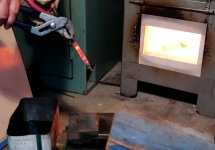First, take the "sealer" and throw it away, they are usually some cheap plastic part. Wrap it up and put in a cold oven. Turn the oven on. Hopefully it's programmable. Once the temp gets to 1200 F hold it there for 10-15 min to get the molecules ready, then take it up to 1750 F for an hour per inch of thickness, if it's under an inch 45 min total is fine. Once it's done, take the part out of the oven and set on a rack or something that will allow air to flow all around it, don't set it on a metal table. Some people in your last post were saying to remove it from the foil, I never do, I think it cools down too fast, which may warp the piece. Once I can comfortably hold it in my hand for a few seconds, it's cooled down enough (about 150 F) and I put it back in the oven. For a punch and die, I'm guessing you want it 56-60 RC? The oven at 700 F would give you about 56, if you want it harder set the oven lower, I wouldn't go below 400 F. Leave it in the foil, in the oven for 2 hrs per inch of thickness, less than one inch, still leave it at 2 hrs. Now when you take it out, you can remove the foil, unless you want a second temper to further remove stresses. If you want a second temper leave the part in foil and Let the part cool and Set the oven 25 F less than the first temper and leave it in at the same time


 always looking forward to new things to learn.
always looking forward to new things to learn.
